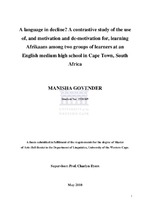| dc.contributor.advisor | Koch, S. E. | |
| dc.contributor.author | Haupt, Genevieve Ruth | |
| dc.contributor.other | Dept. of Psychology | |
| dc.contributor.other | Faculty of Arts | |
| dc.date.accessioned | 2013-12-04T13:43:14Z | |
| dc.date.available | 2011/02/15 12:07 | |
| dc.date.available | 2011/02/15 | |
| dc.date.available | 2013-12-04T13:43:14Z | |
| dc.date.issued | 2010 | |
| dc.identifier.uri | http://hdl.handle.net/11394/2512 | |
| dc.description | Magister Artium (Psychology) - MA(Psych) | en_US |
| dc.description.abstract | South Africa's Language-in-Education Policy is one of additive multilingualism, but in reality this policy is not adhered to, in that most black children are being educated through the medium of English from Grade 4. This type of instruction affects the development of academic language proficiency in their primary language, as these children are not engaging in cognitively demanding tasks in their primary or first language. The Woodcock Muñoz Language Survey (WMLS) is a test to assess academic language proficiency in Additive Bilingual Education, and is extensively used in the United States of America (USA) for this purpose. It is important to note that the proposed study is a sub-study of a larger study, in which the original WMLS (American-English version) was adapted into English and Xhosa, to be used in South Africa to assess additive bilingual programmes. For this sub-study, the researcher was interested in examining the overall equivalence of the adapted English version of the WMLS. Owing to insufficient tests evaluating academic language proficiency in the South African context, the significance, as well as the overall aim, of the study is to ensure that the issues of group difference and item bias have been assessed to ensure that the adapted English version of the WMLS is suitable to be used across English first-language and Xhosa first-language speakers. Because this is a sub-study, the researcher (of the sub-study) has conducted an exploratory quantitative study with the use of Secondary Data. The researcher has used the framework of equivalence as a theoretical framework in order to examine the research question. Given the use of existing data, the procedures of the collection of the data by the researcher of the larger study have been outlined in the Methodology section of the present study. The sample consisted of 198 English and 197 Xhosa first-language speakers. | en_US |
| dc.language.iso | en | en_US |
| dc.publisher | University of the Western Cape | en_US |
| dc.subject | Language Proficiency | en_US |
| dc.subject | Woodcock Muñoz Language Survey | en_US |
| dc.subject | Language in Education | en_US |
| dc.subject | Language Assessment | en_US |
| dc.subject | Monolingual Assessment | en_US |
| dc.subject | Cross-cultural Assessment | en_US |
| dc.subject | Bias | en_US |
| dc.subject | Equivalence | en_US |
| dc.title | The evaluation of the group differences and item bias of the English version of a standardised test of academic language proficiency for use across English and Xhosa first-language speakers | en_US |
| dc.type | Thesis | en_US |
| dc.rights.holder | University of the Western Cape | en_US |
| dc.description.country | South Africa | |




